Latin Quarter off the beaten path: From James Joyce to Black Venus
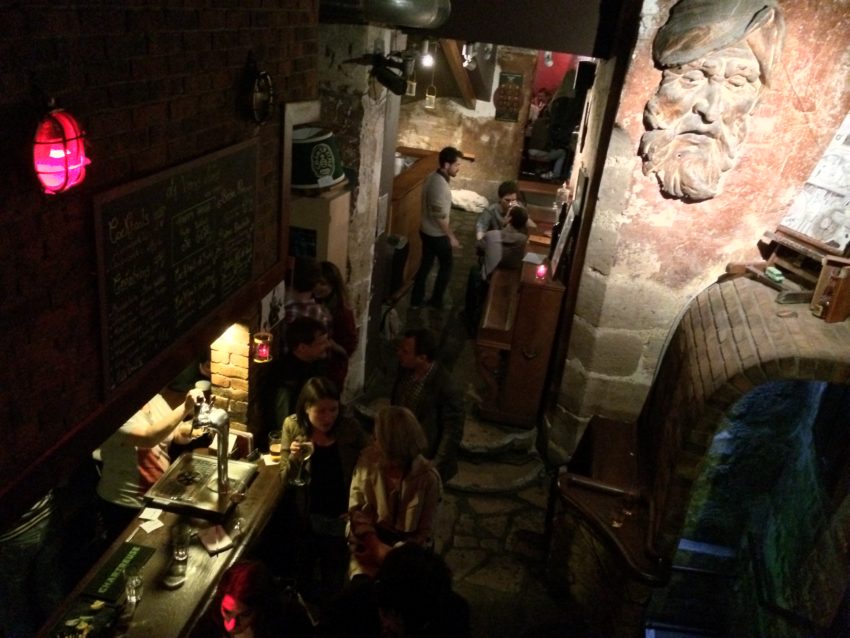
PARIS — The mask of Zeus stared at me from a stone wall first built in the 12th century. He had a blank, sleepy look, sort of like mine as I sat at a bar so dark I kept looking around for bats. I was in La Venus Noire, which a local had told me was the best dive bar in all of the Latin Quarter. He was right. I’d expand it. La Venus Noire (Black Venus) is one of the best dive bars in Europe. Rome has nothing on this place. It was a great way to end a fantastic week in Paris, finishing a day prowling the Latin Quarter off the beaten path.
It isn’t as hard as you’d think. After a week in this neighborhood, I found little pockets away from some of the 32 million tourists who make Paris the most touristy city in the world. The Latin Quarter is arguably the most touristy arrondissement in Paris. The narrow, windy streets that snake down toward the Seine are lined with bars, restaurants and people speaking just about every language but Parisian French. It’s a good place to get a pulse on Paris tourism. During a visit after the U.S. invaded Iraq in 2003, I asked a waiter in a Tunisian restaurant if he had ever met an American who supported Pres. Bush.
“Not one,” he said, smiling. “I don’t think they ever leave America.”
I love the Latin Quarter for its energy. Its vibe is pure upbeat, from the student bars along my Rue des Ecoles to the book stalls along the Seine to the bustling restaurants on the side streets twist down from Rue de Saint-Michel. I hate to hear people, Parisians and Europhiles both, roll their eyes when I say I always stay in the Latin Quarter. It’s like saying you eat at McDonald’s. So I set out to discover the soft underbelly of the Latin Quarter. I sought places the tourists don’t frequent unless pointed out by a neon sign from above their hotel.
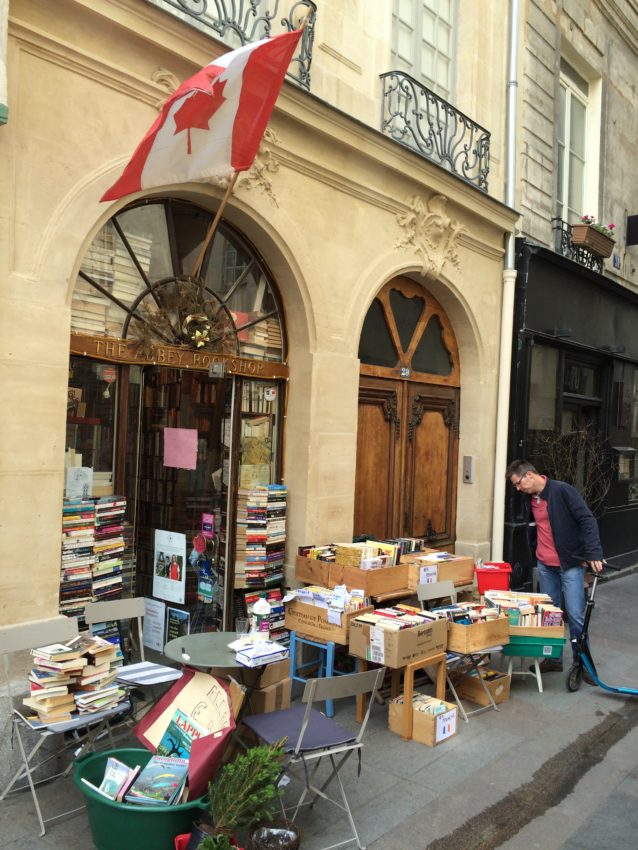
I started out going to a good local source. Abbey Bookstore has occupied a spot on a tiny side street just north of Rue Saint-Germain for 26 years. The Canadian owner, Brian, waves a Canadian flag out front over big stacks of overflow books. He sells coffee with maple syrup in the back. Tall, fit and bearded, Brian used to teach French in Toronto so his transition has been smoother than most. Then again, more Parisians speak English than many think.
“I’d like to go someplace warmer and by the sea,” he said. “But this may be the best bookstore market on the continent.”
His books are new and used and pack bookshelves so close together I nearly had to slide sideways to read the titles. Nearly all were in English. Expats flock to this place. So do some of the more learned Parisians. Brian loves the Latin Quarter. He wouldn’t live anywhere else.
“The side streets and niches in the Latin Quarter are all filled with interesting little places,” he said.
Like this one.
Brian told me some history of the Latin Quarter. From the 12th century it was once called l’Universite’ because more than 60 colleges that make up the University of Paris, with the Sorbonne as the anchor, made this Paris’ center for learning. In the 18th century it changed to La Pays (The Country) then changed to the Latin Quarter about the time they stopped speaking Latin here in 1789.
I love bookstores. I love neighborhood niches. I could’ve stayed there all day, sipping maple syrup-induced coffee, browsing the massive science fiction section and talking to Brian about Paris, French wine and ice hockey. But my backpack was filled to the brim and I didn’t want to pay EasyJet’s larcenous $50 baggage fee for checking a bag or bringing a second carry on.
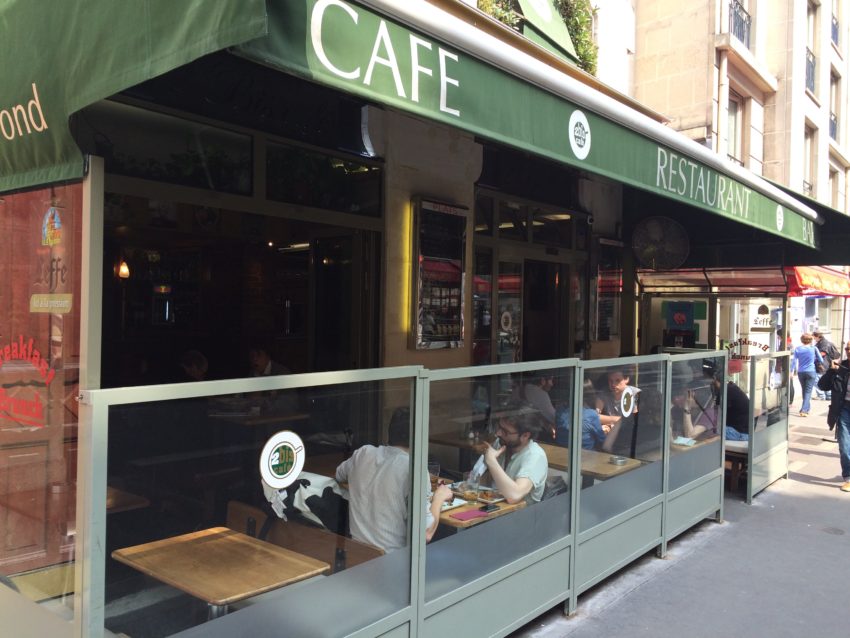
I ventured back down Rue des Ecoles on the same route I took the night before to a real weak American movie, with French subtitles, called “Hacker” (“Blackhat” in the U.S.) The movie wasn’t very good but the bustling student bar across the street was great for an early evening cafe. I dropped by 2Bis Cafe for lunch and sat at a cramped corner table in the sun. The students who packed the place at night were replaced by local workers from various businesses around the neighborhood. Sharply dressed women and overworked Parisian men munching salad while pecking away at their laptops. You don’t see this in Rome. In Rome, work is work and dining is … well, nothing gets in the way of the dining experience. Nothing. In this mode, Paris resembles Milan or New York but the food is just as spectacular.
I ordered a “Double Steak” with fat French fries. The steak glistened in its medium rare splendor and the pepper sauce was the perfect accompaniment, not to mention the Belgian beer with 8.5 percent alcohol.

Wondering if I could work out eight days a week to work off this French food, I ventured up the hill to one of the great unknown historical sites in Paris. I have been coming to Paris for 37 years and I have almost always stayed in the Latin Quarter. Yet I had no idea a Roman colosseum remained here. It’s marked by a tiny sign reading Arenes de Lutece over a small doorway. In the 2nd century, this arena held 10,000 people for gladiator battles and dramatic productions. The Romans occupied Paris for 200 years and used gladiator battles to entertain the locals and also give them an idea of what’s in store for them if they don’t pay their taxes. I graduated from Rome’s gladiator school in 2002. They were the first Nazis. Warfare was demanded. Blood was cherished. Bravery was worshipped.
I sat at the top row of what would’ve been about Row XX in one of its two remaining grandstands. I looked down at old men playing the ancient French lawn bowling game, petanque, in the sand while a group of young teens practiced soccer penalty kicks against the wall. The place crawled with flirting teen-agers drinking soft drinks and eating baguettes. They stared at my note taking as if I was an alien.
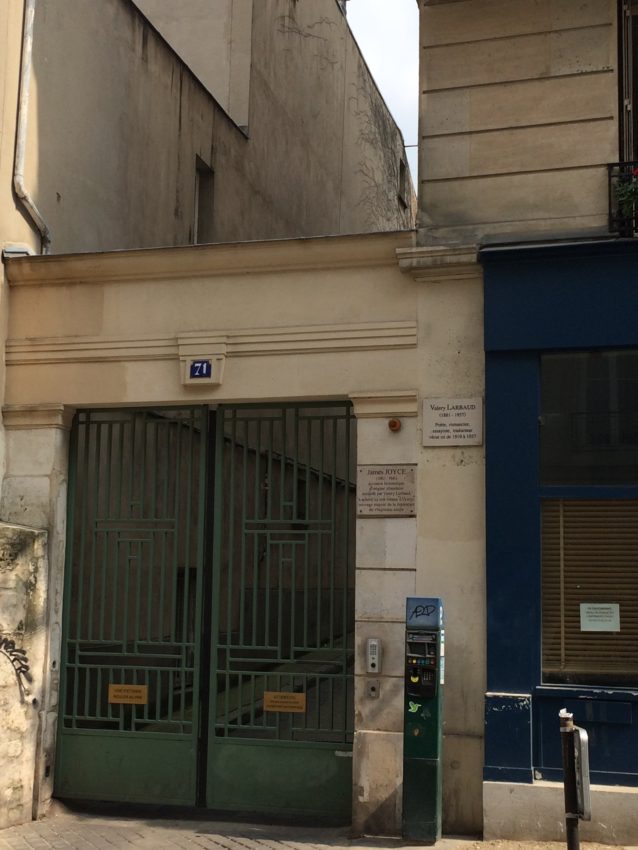
Maybe I feel at home in the Latin Quarter for another reason. This was the literary center of Paris. Not only did Hemingway live in two apartments here, James Joyce lived just down the road from the colosseum. When he moved to Paris in 1921 at age 39, he edited “Ulysses” in a flat down a long corridor on Rue du Cardinal Lemoine. A plaque above the locked iron gate marks the spot. Unfortunately, I wasn’t terribly moved.
Like most college grads, I tried to read “Ulysses” and couldn’t get past the first chapter before picking up the nearest sports section. “His Finnegan’s Wake” remains the most incomprehensible piece of rubbish in the English language. Yet I can’t deny another writer his success. I doubt in 2165 there will be a plaque on my building overlooking the Tiber reading, “Here was the residence of John Henderson (2014-????). Here is where Mr. Henderson wrote about erotic Mexican hotels.”
That won’t happen.
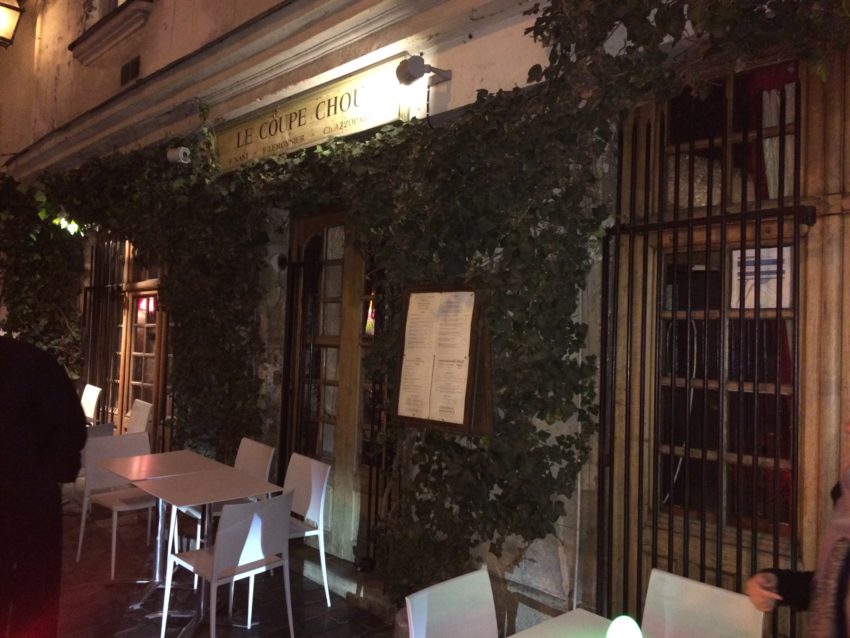
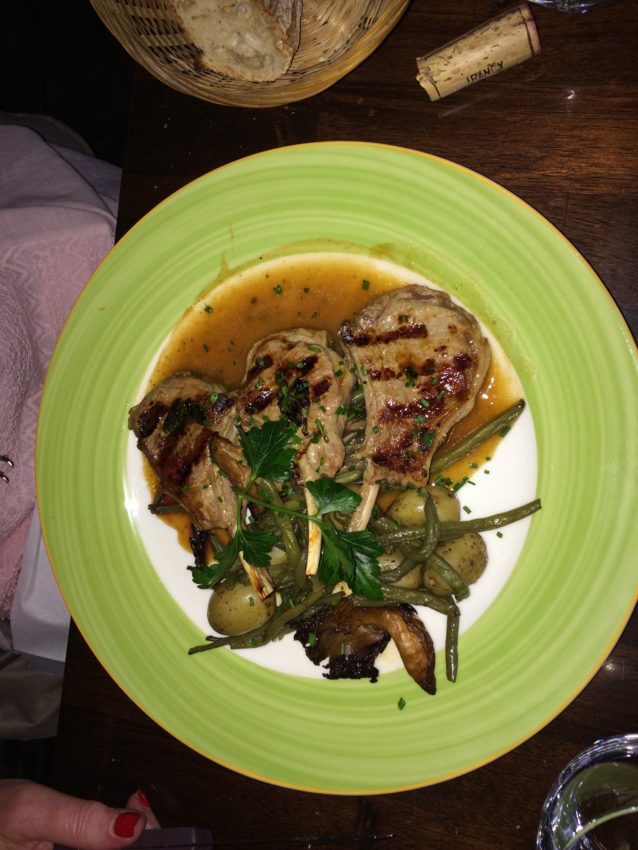
Eating off the beaten path in the Latin Quarter isn’t hard. There are so many little side streets and so many restaurants, none of which would last more than 30 days if not top notch. I took Brian’s recommendation and went to a place I knew would be good because I couldn’t pronounce it. Le Coupe-Chou (Le Coop-Shoe) is in a 17th century townhouse covered in ivy on the side street Rue de la Lanneau. It is down the street from a pulsating college bar packed with beer-swigging students oblivious to the increasingly cold, windy evening. Le Coupe-Chou is the epitome of Paris romance. Candles adorn all the tables that fill small rooms connected by a narrow hallway. My room near the tiny bar had a fireplace that I could imagine blazes away in the winter, making you feel as if you’re back in the Paris of King Henry IV. Soft violin music played over the subtle loudspeakers.
Romance is great but can be ruined with lousy food. Don’t ever dine in skyscrapers with dreamy views. You’ll throw the overcooked steak off the observatory level. But Le Coupe-Chou had food fit for King Henry. I ordered the — get this — Confit de Canard Poele de Grenailles haricots verts pleurotes et champignons de Paris. That’s VERY French for roast duck with green beans and mushrooms. Not to say that it was tender but the knife was unnecessary. It fell off my fork when touched. The skin was crispy and rich. The meat dark and juicy. I ordered a cheese plate of Comte, goat and brie and a chocolate mousse with creme fraiche on the side. Add a 2011 bottle of Thierry Richoux, a great red from Bourgogne, and I had enough romance to last me, well, until the next morning.
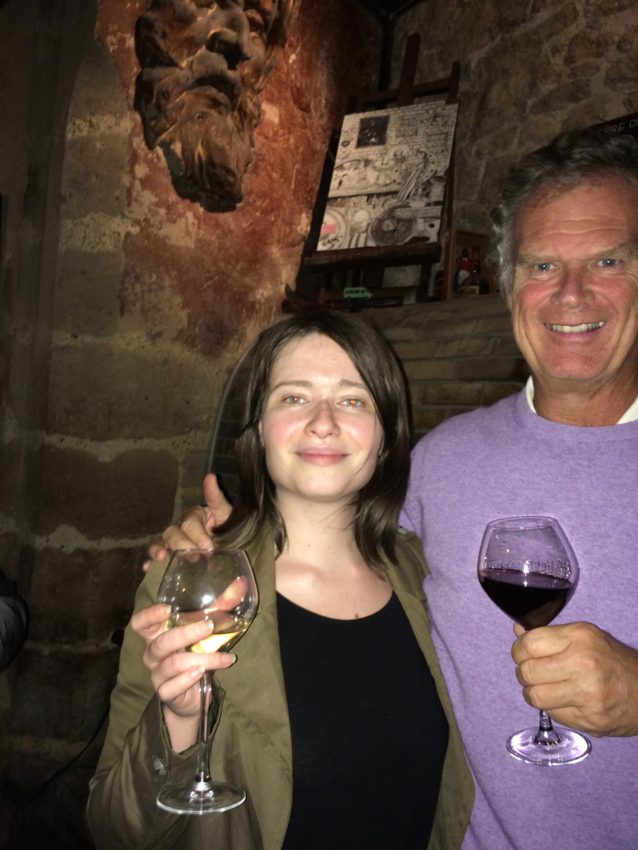
Later, I went from high-end Latin Quarter to the bowels of the back alleys. La Venus Noire is, literally, in a back alley. It’s marked by a single door and no windows. A dark, small sign indicates a passageway into the Latin Quarter’s inner circle. I walked in and felt as if I was in a medieval dungeon. A blacktopped bar interrupted an ancient brick wall that flowed into rock archways I recognized from the Roman Forum. A narrow spiral stairwell descends into what used to be a drain. Before I ordered my first glass of cheap red wine, a bubbly 30-year-old named Esmeralda said, “Come here.” She gave me a quick history of the place, pointing out the Zeus mask and another on another stone stairwell that dates to the 16th century.
“Oscar Wilde hung out here in the ‘20s,” she said. She took me to a back room packed with a 30ish crowd pounding beers. Sure enough, on the wall was a great big “OSCAR WILDE” written by the one and only after a few too many Beaujolais.
Esmeralda, 30, lived upstairs with her boyfriend. They pay 1,200 euros for a flat that measures 45 square meters and they received a discount due to noise that would keep awake grizzly bears. Pretty and shapely, Esmeralda loves her Paris which she has lived in since moving there from the suburbs after high school. She works in a nearby bookstore which seems to be the main source of employment in the Latin Quarter. There’s a bookshelf on every block, giving credence to the 60 colleges in the neighborhood and France’s terrific literary history.
This is a very smart crowd. While Romans are smart enough not to get drunk, Rome’s number of bookstores is dwarfed 10 fold by its number of churches. The chain Feltrinelli dominates the Rome bookstore scene. It has a great English-language section but has the atmosphere of Starbucks. France’s bookstores make you think Hemingway is going to be doing a signing at any minute.
I swilled cheap red wine all night and talked to Esmeralda about Parisians. After a week, I’ve concluded they’re among the friendliest people I’ve ever met. It’s not just because I’m a tourist. It’s not just because I try to speak French — and fail miserably. I asked her why she thinks so many Americans don’t like Parisians.
“It’s because (Americans) love you too much,” she said. “They go, ‘OH, YOU’RE GREAT! YOU’RE WONDERFUL’ and try to give you a hug. Wait. I don’t know you. It’s sweet. But it’s not real.”
The Parisian hospitality is real. I’m writing this from another favorite stop. L’Authre (pronounced Loat) is my corner cafe across the street from my apartment. I had their continental breakfast and asked if I could just hang out and write until I left for the airport. The tall, wiry waiter with the semi afro said no problem. I’m an American in Paris. I’m an American in the Latin Quarter. I’ll be in Rome in a few hours. But Paris will never leave me. I will smell the cafe and the duck confit forever.

